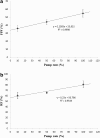Design, characterization, and aerosol dispersion performance modeling of advanced spray-dried microparticulate/nanoparticulate mannitol powders for targeted pulmonary delivery as dry powder inhalers
- PMID: 24502451
- PMCID: PMC3967386
- DOI: 10.1089/jamp.2013.1078
Design, characterization, and aerosol dispersion performance modeling of advanced spray-dried microparticulate/nanoparticulate mannitol powders for targeted pulmonary delivery as dry powder inhalers
Abstract
Background: The purpose was to design and characterize inhalable microparticulate/nanoparticulate dry powders of mannitol with essential particle properties for targeted dry powder delivery for cystic fibrosis mucolytic treatment by dilute organic solution spray drying, and, in addition, to tailor and correlate aerosol dispersion performance delivered as dry powder inhalers based on spray-drying conditions and solid-state physicochemical properties.
Methods: Organic solution advanced spray drying from dilute solution followed by comprehensive solid-state physicochemical characterization and in vitro dry powder aerosolization were used.
Results: The particle size distribution of the spray-dried (SD) powders was narrow, unimodal, and in the range of ∼500 nm to 2.0 μm. The particles possessed spherical particle morphology, relatively smooth surface morphology, low water content and vapor sorption (crystallization occurred at exposure above 65% relative humidity), and retention of crystallinity by polymorphic interconversion. The emitted dose, fine particle fraction (FPF), and respirable fraction (RF) were all relatively high. The mass median aerodynamic diameters were below 4 μm for all SD mannitol aerosols.
Conclusion: The in vitro aerosol deposition stage patterns could be tailored based on spray-drying pump rate. Positive linear correlation was observed between both FPF and RF values with spray-drying pump rates. The interplay between various spray-drying conditions, particle physicochemical properties, and aerosol dispersion performance was observed and examined, which enabled tailoring and modeling of high aerosol deposition patterns.
Figures











Similar articles
-
Physicochemical characterization and aerosol dispersion performance of organic solution advanced spray-dried microparticulate/nanoparticulate antibiotic dry powders of tobramycin and azithromycin for pulmonary inhalation aerosol delivery.Eur J Pharm Sci. 2014 Feb 14;52:191-205. doi: 10.1016/j.ejps.2013.10.016. Epub 2013 Nov 9. Eur J Pharm Sci. 2014. PMID: 24215736
-
Design, characterization, and aerosol dispersion performance modeling of advanced co-spray dried antibiotics with mannitol as respirable microparticles/nanoparticles for targeted pulmonary delivery as dry powder inhalers.J Pharm Sci. 2014 Sep;103(9):2937-2949. doi: 10.1002/jps.23955. Epub 2014 Apr 16. J Pharm Sci. 2014. PMID: 24740732
-
Physicochemical characterization and water vapor sorption of organic solution advanced spray-dried inhalable trehalose microparticles and nanoparticles for targeted dry powder pulmonary inhalation delivery.AAPS PharmSciTech. 2011 Dec;12(4):1420-30. doi: 10.1208/s12249-011-9704-0. Epub 2011 Oct 25. AAPS PharmSciTech. 2011. PMID: 22038473 Free PMC article.
-
Spray-Dried Inhalable Powder Formulations of Therapeutic Proteins and Peptides.AAPS PharmSciTech. 2021 Jun 18;22(5):185. doi: 10.1208/s12249-021-02043-5. AAPS PharmSciTech. 2021. PMID: 34143327 Review.
-
Recent advances in dry powder inhalation formulations prepared by co-spray drying technology: a comprehensive review.Int J Pharm. 2025 Aug 20;681:125825. doi: 10.1016/j.ijpharm.2025.125825. Epub 2025 Jun 8. Int J Pharm. 2025. PMID: 40494455 Review.
Cited by
-
Inhaled Nanoparticulate Systems: Composition, Manufacture and Aerosol Delivery.J Aerosol Med Pulm Drug Deliv. 2024 Aug;37(4):202-218. doi: 10.1089/jamp.2024.29117.mk. J Aerosol Med Pulm Drug Deliv. 2024. PMID: 39172256 Free PMC article. Review.
-
A Novel Combined Dry Powder Inhaler Comprising Nanosized Ketoprofen-Embedded Mannitol-Coated Microparticles for Pulmonary Inflammations: Development, In Vitro-In Silico Characterization, and Cell Line Evaluation.Pharmaceuticals (Basel). 2024 Jan 7;17(1):75. doi: 10.3390/ph17010075. Pharmaceuticals (Basel). 2024. PMID: 38256908 Free PMC article.
-
Advanced design and development of nanoparticle/microparticle dual-drug combination lactose carrier-free dry powder inhalation aerosols.RSC Adv. 2020 Nov 17;10(68):41846-41856. doi: 10.1039/d0ra07203f. RSC Adv. 2020. PMID: 33391731 Free PMC article.
-
Comprehensive Physicochemical Characterization, In Vitro Membrane Permeation, and In Vitro Human Skin Cell Culture of a Novel TOPK Inhibitor, HI-TOPK-032.Int J Mol Sci. 2023 Oct 24;24(21):15515. doi: 10.3390/ijms242115515. Int J Mol Sci. 2023. PMID: 37958502 Free PMC article.
-
Comprehensive Physicochemical Characterization and in Vitro Human Cell Culture Studies of an Innovative Biocompatible and Biodegradable Silk-Derived Protein Hydrolysate, SDP-4.ACS Omega. 2025 Jan 14;10(3):2762-2777. doi: 10.1021/acsomega.4c08514. eCollection 2025 Jan 28. ACS Omega. 2025. PMID: 39895742 Free PMC article.
References
-
- Gibson RL, Burns JL, and Ramsey BW: Pathophysiology and management of pulmonary infections in cystic fibrosis. Am J Respir Crit Care Med. 2003;168:918–951 - PubMed
-
- Elphick H, and Southern K: Antifungal therapies for allergic bronchopulmonary aspergillosis in people with cystic fibrosis. Cochrane Database Syst Rev. 2000;(4):CD002204. - PubMed
-
- Hickey AJ, and Mansour HM: Delivery of drugs by the pulmonary route. In: Florence AT, and Siepmann J, (eds). Modern Pharmaceutics. Taylor & Francis, New York; pp. 191–219, 2009
-
- Hickey AJ, and Mansour HM: Formulation challenges of powders for the delivery of small molecular weight molecules as aerosols. In: Rathbone MJ, (ed). Modified-Release Drug Delivery Technology. Informa Healthcare, New York; pp. 573–602, 2008
-
- Hickey AJ, Mansour HM, Telko MJ, Xu Z, Smyth HD, Mulder T, McLean R, Langridge J, and Papadopoulos D: Physical characterization of component particles included in dry powder inhalers. I. Strategy review and static characteristics. J Pharm Sci. 2007;96:1282–1301 - PubMed
Publication types
MeSH terms
Substances
LinkOut - more resources
Full Text Sources
Other Literature Sources
